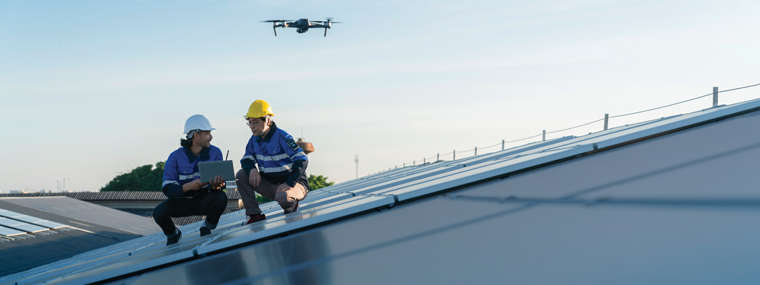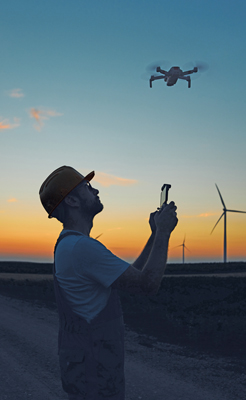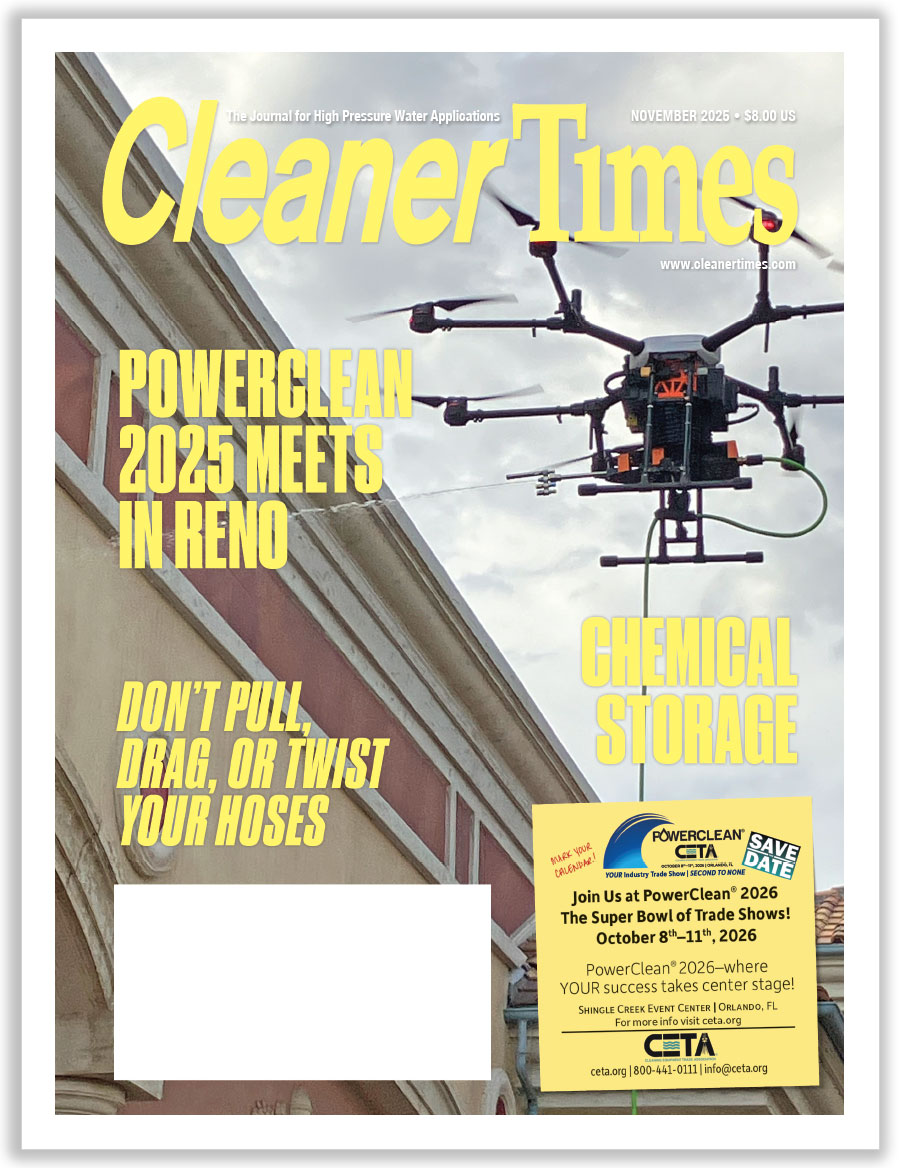
Deploy the Drones
By Diane M. Calabrese / Published April 2023

No ladders, no scaffolds, no harnesses, and the job gets done. It sounds good, but is it the future or an ephemeral fantasy?
Drones are being deployed already in the service of soft washing, window washing, and even paint applications. Use any search engine and find several companies now marketing drones to support power washing.
Wherever the market is heading, one thing is certain—regulation of drones is serious and expansive. The Federal Aviation Administration (FAA) has the responsibility for regulating drones. Drone operators must be fully trained and comply with all federal and local laws. (More about this in the last section.)
Drones are expensive. That may change as they become more common.
Configuration of a drone for cleaning must also be resolved. Water supply to the drone, via a tethered hose, limits the height. At the same time, what one gains in safety from the absence of the usual mechanisms for working high is chipped away at by the precarious nature of a dangling hose.
So where to start? Assume nothing.
Begin with insurance for drones. “There is risk in everything you do, but drones can be very helpful and a good tool,” says Tom Svrcek, president, CSC Insurance Options and Joseph D. Walters Insurance in Belle Vernon, PA.
“If you assume you have automatic coverage, you’re making a big mistake,” explains Svrcek. “Communicate with your insurance agent, and always deal with an agent who specializes.”
It’s not uncommon for policy holders to fail to understand the limitations. “Most clients make a lot of assumptions,” says Svrcek. “The assumption they have automatic coverage on drones is one.”
Review a policy carefully. “Most general liability policies exclude liability—damage that results in bodily injury or any property damage as a result of drone usage,” says Svrcek. “So, there is no coverage unless additional coverage is specifically purchased. Furthermore, the physical damage of the drone for any type of damage is not covered.”
To date, has Svrcek heard of a contractor being held liable for a drone mishap? “Yes, drones crash and clients that don’t disclose and buy additional coverage are at a loss,” he says.
“There are a lot of coverages that clients only find out aren’t included when a claim occurs and there is no coverage,” says Svrcek. “Don’t find out the hard way…Talk to your agent.”
Pilotless and Promising
Pilotless aircraft that are controlled remotely. That’s a good definition of a drone.
As for the origin of the name “drone,” it has the look of an acronym but it’s not. Etymologists tie the origin to either bee species that have workers, drones, and queen forms (e.g., honeybee) or to a humming sound made by the devices (at least the early ones).
As for early drones, remotely-piloted vehicles (RPVs) were used in World War II. The moniker drone began to be used sometime in the mid-1940s.
The promise of drones in the hands of contractors is real. And it’s being pushed forward and tested, particularly by software companies looking to expand their reach.
A case study called “Man vs. Drone” was done by Apellix®, a software company based in Jacksonville, FL, that develops controls and configurations for drones. Read about how a team in a lift cleaned one half of a water tower with a tethered drone cleaning the other half via https://www.apellix.com/power-wash-case-study. (The company is the NACE [National Association of Corrosion Engineers] CoatingsPro Contractor Awards 2022 winner.)
Other software developers that have entered the drone sector with trials in power washing are Aquiline Drones in Hartford, CT, and Lucid Drone Technologies in Charlotte, NC. Trials and testimonies from power
washing contractors who have given drones a try can be found on their websites.
Soft washing seems to be a particularly good fit for application by drone because so much less water is required. Those developing drones that can be used for soft washing, window cleaning, and exterior cleaning put the efficiency gain at between 15 and 25 percent over conventional approaches.
Whether the increased efficiency is enough to make a drone purchase economical depends on many factors. The cost of drone insurance (for replacement and liability), the mode of wastewater collection, and the limitations in using remotely controlled craft in certain weather conditions are some of the factors.
Moreover, drones may not be used in designated restricted air spaces. The National Capital Region (NCR) falls under an SFRA [specific flight rules area] designation. Drones cannot be flown within a 15-mile radius of the center of the region. If certain conditions are met, a recreational drone weighing less than 55 pounds can fly within the concentric ring bordered by the 15- to 30-mile radius.
No airspace is more restricted than that in the NCR. Still, before investing in a drone, a contractor must be certain restrictions on flying will not impede the use of the craft.
There are many design issues to be resolved. Batteries to power drones add weight. So do chemicals that are carried to be added to the water stream.
There are safety concerns. A tethered power supply would lighten a drone, but a hose and power cord dangling from a drone—wires or building flourishes could easily snare either one or both.
Then, there’s the line of sight of the drone operator. Keeping the drone in view while looking up may lead to fatigue. Just a bit of weariness is enough to send the drone in an errant direction.
Despite the issues to be resolved and performance factors to be refined, drones are being adopted. According to the FAA, 333,946 commercial drones were registered in 2021 out of a total of 871,984 drones registered.
FAA In Control
Unless a drone weighs less than 0.55 pounds (250 grams) and meets the exception for recreational flyers, it must be registered. Beginning on September 16, 2023, each drone operator must also comply with remote ID registration. (All drones produced after September 16, 2022, must have as a standard feature built-in remote ID.)
The FAA registration fee is modest at $5 per drone for three years. When operating a drone, an individual must be prepared to show a drone registration certificate to any federal, state, or local law enforcement officer. A drone owner must also label the pilotless craft with the registration number.
The registration requirement alone puts drones in a different category from pressure washers. No contractor expects a law officer to want to see a registration for a pressure washer or surface cleaner, but a drone is a different matter.
A good place to begin if considering drone deployment is at the FAA.gov site, which has a portal dedicated to all things drones. Find information about registration, certification, and more.
The FAA has a campaign called Drone Safety Day (DSD), an annual event to highlight benefits of drone operation—safe drone operation—to society and economy. It includes in-person, virtual, and hybrid sessions. The date for this year’s DSD is April 29.
Even those who miss the event can go to the FAA website and download a copy of the 2023 Drone Safety Day Playbook. In the future, the ideas in the playbook might serve as the template for a regional meeting or session at an annual meeting for professional associations tied to our industry.
While software and technical companies have taken the lead in finding a way to couple power-washing tools and remote control of airborne machines, full exploitation will likely require more interaction with equipment manufacturers. Manufacturers immersed in our industry are best situated to identify and find workarounds for issues such as water and power supply to an airborne vessel and wastewater collection.
The National Environmental Policy Act (NEPA) requires the FAA to verify users of airspace do not contribute in significant ways to negative alteration of the environment. (NEPA became law on January 1, 1970.)
We have all read news reports of major companies testing drone delivery of packages in certain parts of the nation. Each of the trials had to first go through an NEPA review. “No significant impact” is the FAA conclusion that carries the day and allows the drone activity to continue.
Not all recent NEPA reviews involving drones have been about deliveries. On January 3, 2023, Florida Power and Light (FPL) got a waiver allowing it to use drones to inspect certain infrastructure in the context of assessing damage and preventive maintenance.
The short of it is that NEPA adds to the assurances a manufacturer and distributors and users of drones must provide to regulators. A negative finding could keep a drone from getting airborne.
Bridges, water towers, and windows in high-rise buildings are some of the most obvious places that drone use could improve safety. It’s likely that cost-effectiveness could be demonstrated in such settings.
Whether drones will ever be cost-effective and safe enough to use in residential and commercial settings is an open question. What should we expect? More interest in the possibilities and more trials and experimentation in the near term, some of it at least in a cursory way from manufacturers in our industry.
It will be interesting.






